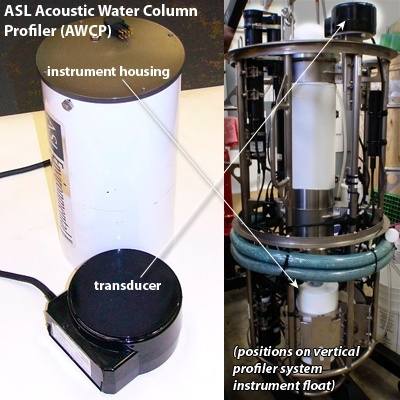

(Click the pictures to enlarge them.)
A BioSonics hydroacoustic echosounder is installed on the Folger Deep instrument platform. The echosounder has three transducers, at frequencies of 38, 123 and 210kHz. These transducers convert electrical signals from the transmitter into acoustic pulses sent out into the water. When the pulses strike animals or other objects in the water, echoes are produced, which can be detected and converted by the transducers back into electrical signals. Software is then used to determine distances, sizes, concentrations and movements of organisms and other objects in the water.
BioSonics DT4 format and ASL AWCP data are supported by the Echoview software (www.echoview.com) for analysis of echosounder data for fisheries, zooplankton and other water column applications.
A public forum (www.fisheriesacoustics.com) is available to connect researchers around the world working in hydroacoustic data analysis and research.


(Click the pictures to enlarge them.)
ASL Acoustic Zooplankton Fish Profilers measure marine environmental conditions in the water column. The AZFP™ can monitor the presence and abundance of zooplankton and fish within the water column by measuring acoustic backscatter returns at multiple ultrasonic frequencies. Other sonar targets realized from the sonar backscatter data include bubbles and suspended sediments.
AZFP™ can collect data continuously for periods of up to one year at high temporal and spatial resolution. The AZFP™ is available with up to four frequencies in a single transducer housing. It can be operated in bottom-mounted, upward looking mode or in downward looking mode from a buoy, and is ideally suited for taut-line mooring operation, but many other options available. The AZFP™ has highly configurable sampling programs.
(From ASL Website)
Kongsberg echosounders can map bathymetry beyond the continental rises (up to 5000m depth) to shallow water basins (10 m depth). Since the maintenance cruise in July 2011, the RV Thompson has been equipped with the Kongsberg E302 system.
The Kongsberg Simrad EM 302 is a complete system. All necessary sensor interfaces, data displays for quality control and sensor calibration, seabed visualization, and data logging are a standard part of the system, as is integrated seabed acoustical imaging capability (sidescan).